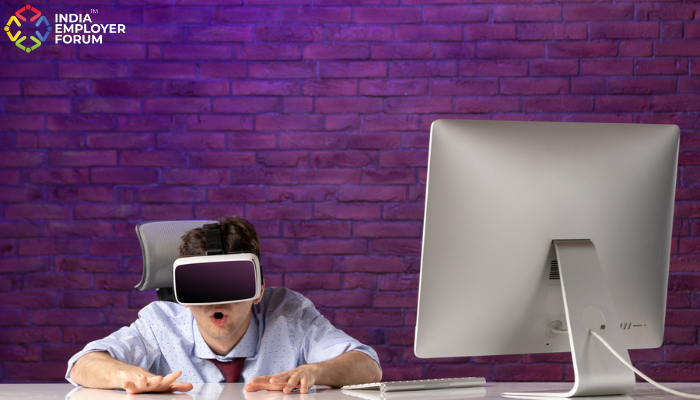With almost one and a half years into the pandemic, most of the workforce in major business industries has embraced the hybrid mode of working. While employees were working only from home in the beginning of Covid-19 outbreak, today most of them often pop into their office, or meet clients at locations that are not their homes, and sometimes on rare occasions have to attend conferences or training events. Due to Covid-19 restrictions, training is not possible in a majority of countries offline, and companies are now working on creating content in order to help train their teams whether they are at home or at their cubicle in the office or in the company conference room.
This means that the content being used for training can no longer be traditional in nature. There is certainly a limitation when it comes to flexibility with the design, analytics, integration and mainly the user interface. Incompatibility of these issues with a workforce that is working in hybrid mode can hinder the success of Learning and Development initiatives. Skills of workers in a setting that is hybrid majorly depends on reimagining the current document. In order for the learning to be experiential in nature, the content has to be interactive and technologically compatible so it can be adopted in a more efficient and speedy manner.
You might also be interested to read: Future Of Work – The Changing Trends
World of work is now hybrid
A recent study suggested that given a choice when the pandemic is over, both employers and employees have shown interest in continuing to work in a combination of offline and online mode.
The true meaning of hybrid workforce is one where some employees go to the office every day full time, some employees work from home full time, and the rest work part time in the office and part time from home. With the pandemic and its impact subsiding, the new norm is a hybrid workforce. A study by Webex revealed that about 50% of employees wish to visit the office only for 10 days or a little less than that every month, whereas a study by Upwork calculated that ¼ of the workforce wants to work remotely all throughout the year 2021. It also estimated the possibility that about 22% of the total workforce will be working either from home or anywhere remotely by the year 2025. That comes down to approximately 36.2 million employees.
The above brings about a new meaning for Learning and Development professionals. A workforce which is working in hybrid mode or completely remotely only increases the complexity of conducting conventional training programs. The professionals working in L&D will have to start thinking unconventionally, out of the box, so that they can engage as well as energize learning in the hybrid mode. For a successful L&D session, it needs to be engaging, interactive and produce a consistent educational experience.
Learning and Development professionals require tools that can help them easily to create content for training which is experiential in nature and can be easily shared across the entire panel of remote workers. These professionals will have to let go of the basic 2D approach that they have generally been accustomed to, and will have to adopt and implement a digital approach that may include polls, animation, videos, presentations and the possibility to be able to choose personalized learning style that exist within the materials that are provided for training and learning.
It is essential for employees to be immersed and engage with their training experience but it is also essential for Learning and Development professionals to be able to distribute, create, and manage the materials that they created for training with ease. Another key element is being able to modify the content and make important adjustments over a period of time.
How to propel experiential learning among a hybrid workforce
Experiential learning is a term that is often thrown about, but what exactly does it mean? It mainly describes the ultimate process of any type of learning and also helps you get to know who you are, as a learner. In addition, it lets you be in charge of self development and learning in an empowered way.
The process of experiential learning includes improvement in one’s performance, development as well as learning of new things. Most L&D professionals believe that there are two major goals in the process of experiential learning. One is to be able to learn aspects about a specific subject while the other is to be aware of one’s personal process involved in learning.
The above is not possible if traditional materials for training are utilized, especially in a world dominated by a hybrid workforce. The training content must be powerful and flexible enough so it can fill in the gaps and help support opportunities for experiential learning in the most effective manner. The type of content being used for training plays a major role in the impact of training and learning.
If the content is interactive, the learning is guaranteed to be absolutely experiential. In today’s digital world where multiple employees use varied software and computers, the content must be supported by all types of media and also all types of media players. It can also be framed in varying styles like quizzes, polls, games, animated presentations so that action can be taken and the new information can be implemented by the employees.
Since employees are now working from home, from office, and some of them are working from both, the training needs to be self driven. This means that it is interactive so that it enables the workforce to drive their own experiences, engage with the content at their own pace and work with the material provided with freedom and in an optimum manner that suits them the best.
The use of smart digital platforms for content can add power to the training and help the workforce that are no longer seated in the same conference room to feel connected. All of this can help fashion a learning experience that is digital yet gives a sense of first hand learning.
Content styled to match future goals
The transition to a world where learning is hybrid is in complete motion, and soon this could be the permanent way. As a result of this, professionals in the field of L&D are working hard at modifying the traditional training content to a content style that is able to meet and match future goals. The challenge being faced is mainly concerning the delivery of consistent training and development materials for a sea of workforce that is mainly hybrid and to ensure that the learning experience is shared even though the teams are dispersed in every sense. For complete success, the experience through the learning and development programs must be felt by every sense of the participant. Keeping this in mind, the most important task is reimagining the content so that hybrid worker’s capabilities and skills can be improved in the most effective way. This can largely be done with content that is technologically compatible, interactive, personalized, easy to use, and flexible to suit individual needs.
Reference: Is Your Training Content Ready for a Hybrid Workforce? | Talent Culture | Darrell Swain | September 14, 2021
You might also be interested to read:




